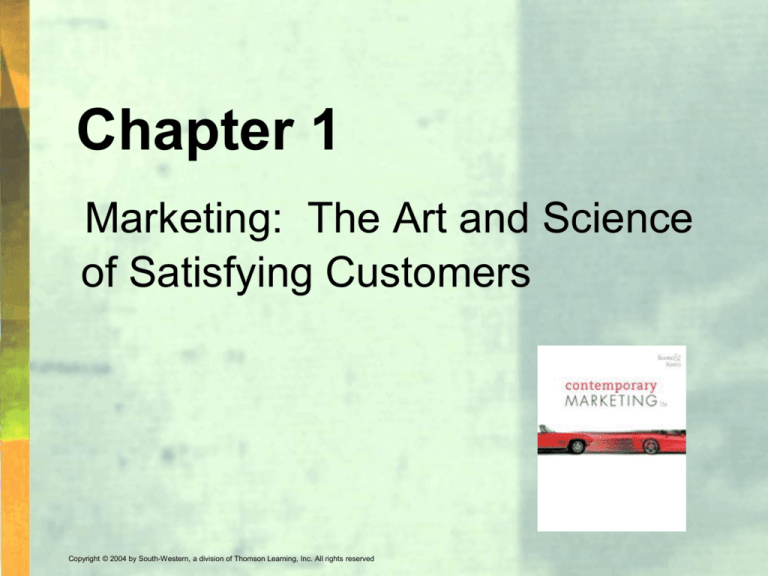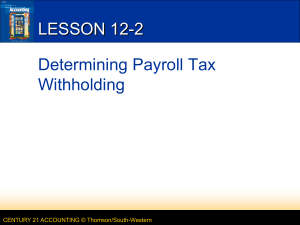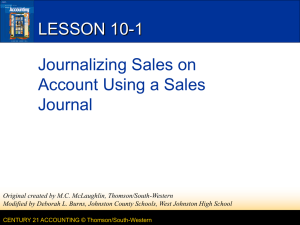
Chapter 1
Marketing: The Art and Science
of Satisfying Customers
Copyright © 2004 by South-Western, a division of Thomson Learning, Inc. All rights reserved.
Objectives
1. Explain how marketing creates utility through
the exchange process.
2. Contrast marketing activities during the four
eras in the history of marketing.
3. Define the marketing concept and its
relationship to marketing myopia.
4. Describe the characteristics of not-for-profit
marketing.
Copyright © 2004 by South-Western, a division of Thomson Learning, Inc. All rights reserved.
Objectives
5. Describe the five types of nontraditional
marketing.
6. Outline the changes in the marketing
environment due to technology.
7. Explain the shift from transaction-based
marketing to relationship marketing.
8. Identify the universal functions of marketing.
9. Demonstrate the relationship between ethical
business practices and marketplace success.
Copyright © 2004 by South-Western, a division of Thomson Learning, Inc. All rights reserved.
Marketing
Marketing is the process of planning and
executing the conception of, pricing, promotion,
and distribution of ideas, goods, services,
organizations, and events to create and
maintain relationships that will satisfy individual
and organizational objectives.
Copyright © 2004 by South-Western, a division of Thomson Learning, Inc. All rights reserved.
AMA Mission Statement
“Our principal roles are:
• To always understand and satisfy the
needs of marketers so as to provide
them with products and services that
will help them be better marketers.
• To empower marketers through
information, education, relationships
and resources that will enrich their
professional development and
careers.
• To advance the thought, application
and ethical practice of marketing.”
Source: AMA, Marketing Power Web Site
Copyright © 2004 by South-Western, a division of Thomson Learning, Inc. All rights reserved.
Music to a Marketer’s Ears
•
•
•
•
“They’re the best.”
“I always eat there.”
“I only fly with that airline.”
“I buy my electronics at that store.”
Copyright © 2004 by South-Western, a division of Thomson Learning, Inc. All rights reserved.
Four Types of Utility
Type
Description
Form
Conversion of raw materials
and components into finished
goods and services
Skippy Peanut Butter; State Farm
automobile insurance policy;
Boeing 767 aircraft
Productiona
Time
Availability of goods and
services when consumers want
them
One-hour dry cleaning;
LensCrafters eyeglass guarantee;
Federal Express’ guarantee of
package delivery by 10:30 a.m.
the next day
Marketing
Place
Availability of goods and
services at convenient locations
Soda machines in school lobbies;
coffee and snacks in Barnes &
Noble bookstores; day cares in
office complexes; ATM machines
in gas stations; mailboxes outside
convenience stores
Marketing
Ownership
(possession)
Ability to transfer title to goods
or services from marketer to
buyer
Retail sales (in exchange for
currency or credit-card payment);
swap meets
Marketing
a Marketing
Examples
Organizational
Function
Responsible
provides inputs related to consumer preferences, but the actual creation of form utility is the responsibility of
the production function.
Copyright © 2004 by South-Western, a division of Thomson Learning, Inc. All rights reserved.
Creating Utility
By creating Time,
Place, and
Ownership Utility,
FedEx is adding
value.
Copyright © 2004 by South-Western, a division of Thomson Learning, Inc. All rights reserved.
Marketing Variables - Marketing Mix
•
•
•
•
Product
Price
Promotion
Distribution
Using the Marketing Mix to build long term relationships.
Copyright © 2004 by South-Western, a division of Thomson Learning, Inc. All rights reserved.
Eight Universal Marketing Functions
1. Buying
2. Selling
3. Transporting
4. Storing
5. Standardizing and grading
6. Financing
7. Risk Taking
8. Securing Marketing Information
Copyright © 2004 by South-Western, a division of Thomson Learning, Inc. All rights reserved.
How to Create Customers
Identifying customer needs
Designing goods and services that meet those
needs
Communicating information about those goods
and services to prospective buyers
Making the goods or services available at times
and places that meet customers’ needs
Pricing goods and services to reflect costs,
competition, and customers’ ability to buy
Providing for the necessary service and followup to ensure customer satisfaction after the
purchase
Copyright © 2004 by South-Western, a division of Thomson Learning, Inc. All rights reserved.
Four Eras of Marketing History
Era Production
Prior to 1920’s
Sales Prior
to 1950’s
Marketing
Since 1950’s
Relationship
Since 1990’s
In the United States and other highly industrialized economies
“A good product
will sell itself.”
“Creative advertising and
selling will overcome
consumers’ resistance and
convince them to buy.”
Copyright © 2004 by South-Western, a division of Thomson Learning, Inc. All rights reserved.
“The consumer rules!
Find a need and fill it.”
“Long term relationships
with customers and other
partners lead to success.”
Relationship Marketing
Netpulse, LLC uses a monitoring system to help in
diagnosing problems from a remote location. They also
provide innovative ways to help their customers, Health
Club Owners, attract members. Netpulse, LLC has the
ability to provide cardiovascular equipment with a flat
LCD screen enabling exercisers to surf the web, listen to
CDs, watch personal TV, and still use the equipment.
This is a good example of providing for a “win, win
situation” leading to Relationship Marketing, the building
of long term relationships.
Copyright © 2004 by South-Western, a division of Thomson Learning, Inc. All rights reserved.
Emergence of the Marketing Concept
• Production Orientation - Market in which there are
more buyers for fewer goods and services.
• Selling Orientation - Market in which there are more
goods and services than people willing to buy them.
• Consumer Orientation - Emphasizes first
determining unmet consumer needs and then designing
a system for satisfying them.
• Marketing Concept - Company-wide consumer
orientation with the objective of achieving long-run
success.
Copyright © 2004 by South-Western, a division of Thomson Learning, Inc. All rights reserved.
Marketing Myopia
Management’s failure to recognize the scope
of its business.
Copyright © 2004 by South-Western, a division of Thomson Learning, Inc. All rights reserved.
Avoiding Marketing Myopia by
Focusing on Benefits vs. Product
Company
Myopic Description
Marketing-Oriented
Description
Sprint
“We are a telephone
company.”
“We are a communications
company.”
Northwest Airlines
“We are in the airline
business.”
“We are in the transportation
business.”
Prudential Securities
“We are in the stock
brokerage business.”
“We are in the financial
services business.”
Sony
“We are in the video game
business.”
“We are in the entertainment
business.”
Starbucks
“We sell coffee.”
Copyright © 2004 by South-Western, a division of Thomson Learning, Inc. All rights reserved.
“We create a beverage
experience.”
Categories of Nontraditional
Marketing
Type
Brief Description
Examples
Person marketing
Marketing efforts designed to cultivate the
attention and preference of a target market
toward a person
Celebrity Britney Spears;
athlete Tiger Woods; political
candidates
Place marketing
Marketing efforts designed to attract visitors to
a particular area; improve consumer images of
a city, state, or nation; and/or attract new
business
Georgia: Experience the Soul
of Georgia; Belize: Catch the
Adventure; Tennessee:
Sounds Good to Me
Cause marketing
Identification and marketing of a social issue,
cause, or idea to selected target markets
“Welfare to Work. It works.”
“Friends don’t let friends
drive drunk.”
Event marketing
Marketing of sporting, cultural, and charitable
activities to selected target markets
NASCAR Pepsi 400;
American Cancer Society
Relay for Life
Organization marketing
Marketing efforts of mutual-benefit
organizations, service organizations, and
government organizations that seek to
influence others to accept their goals, receive
their service, or contribute to them in some
way
U.S. Army: An Army of One.
United Way brings out the
best in all of us. Tech Corps:
America needs to know.
Copyright © 2004 by South-Western, a division of Thomson Learning, Inc. All rights reserved.
Cause Marketing
• “Race for the Cure” – breast cancer awareness
• Smokey Bear
• Safety Belt Education
– crash test dummies
Copyright © 2004 by South-Western, a division of Thomson Learning, Inc. All rights reserved.
Place Marketing,
Form of Nontraditional Marketing
•
What has this type of advertising done
for Louisiana tourism?
– Increased visitor inquiries from
525,000 to over 2.8 million.
– Increased visits to the state by 28%
from 1993 to 2001.
Source: Peter A. Mayer Advertising
Agency
Copyright © 2004 by South-Western, a division of Thomson Learning, Inc. All rights reserved.
Technology Revolution in Marketing
Interactive marketing - Buyer-seller
communications.
Internet - All-purpose global network of 50,000
different networks.
World Wide Web (WWW or Web) - Interlinked
collection of graphically rich information sources within
the larger Internet.
Broadband technology - Extremely high speed,
always-on Internet connection.
Interactive television service - A package that
includes a return path for viewers to interact with
programs on commercials.
Copyright © 2004 by South-Western, a division of Thomson Learning, Inc. All rights reserved.









